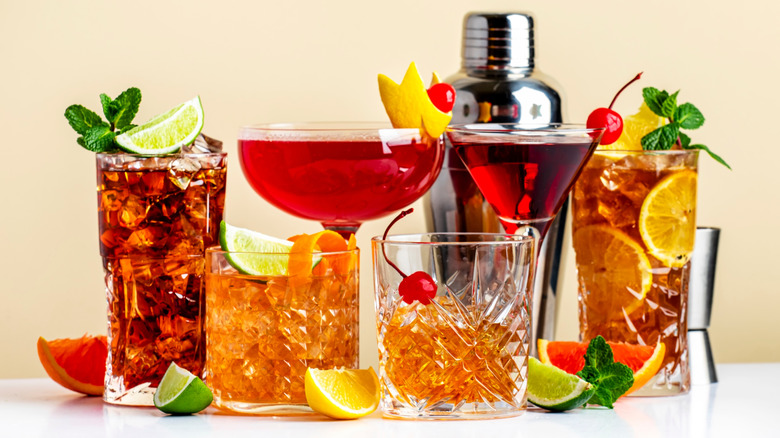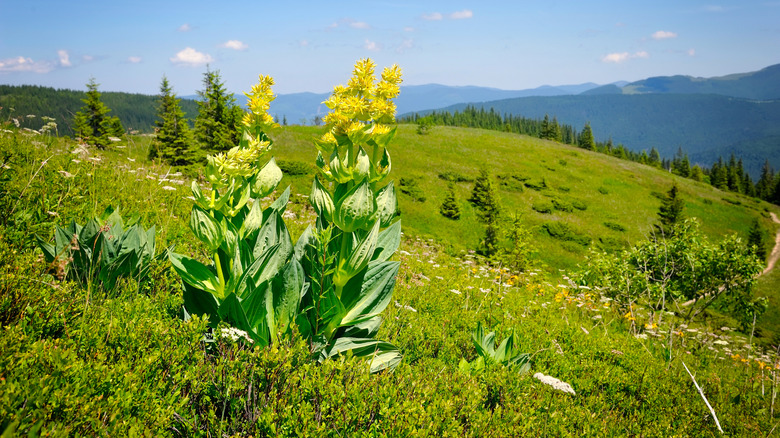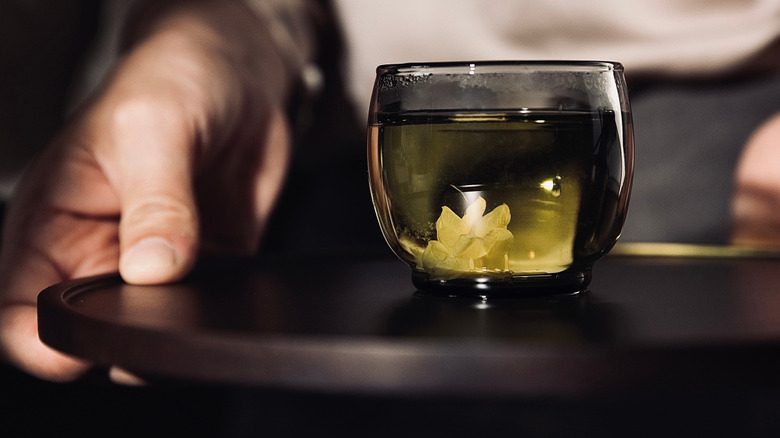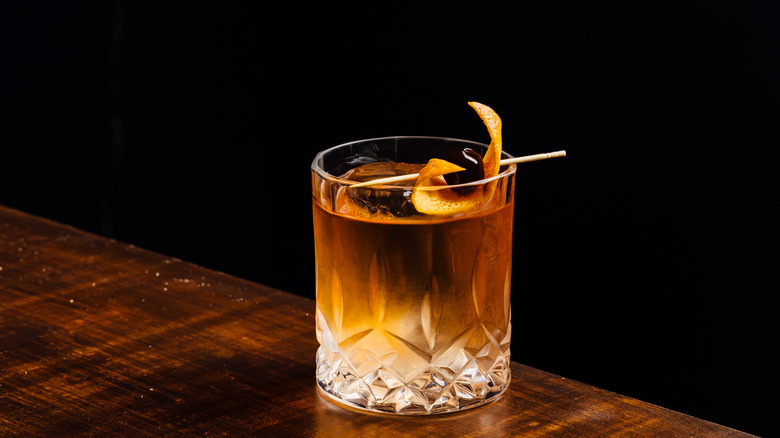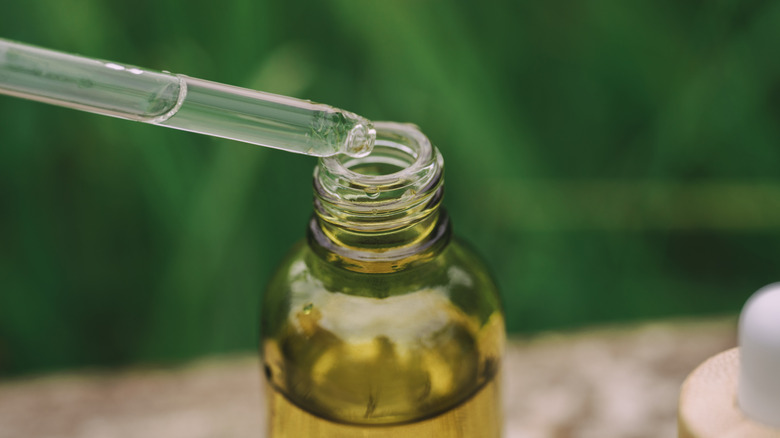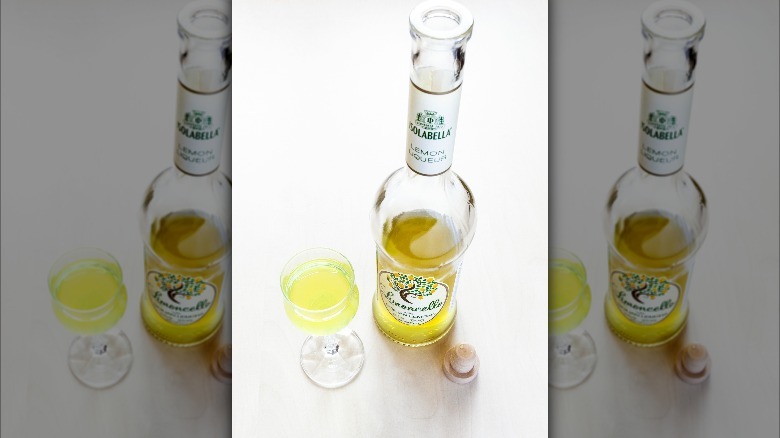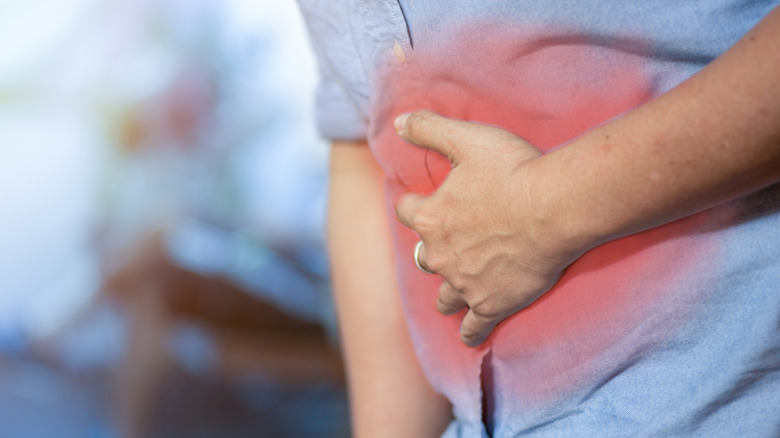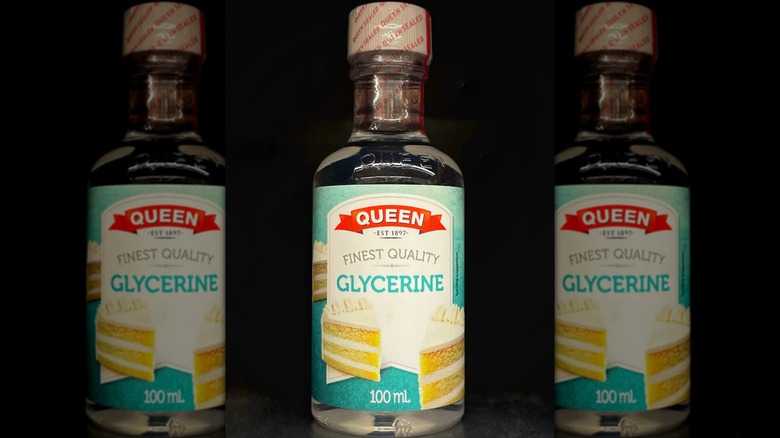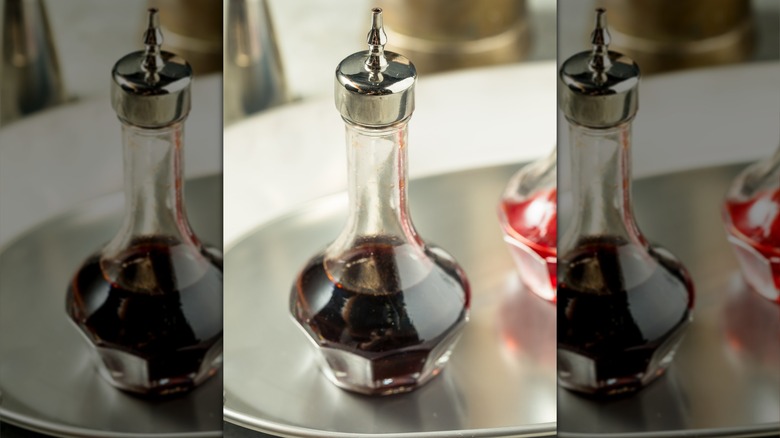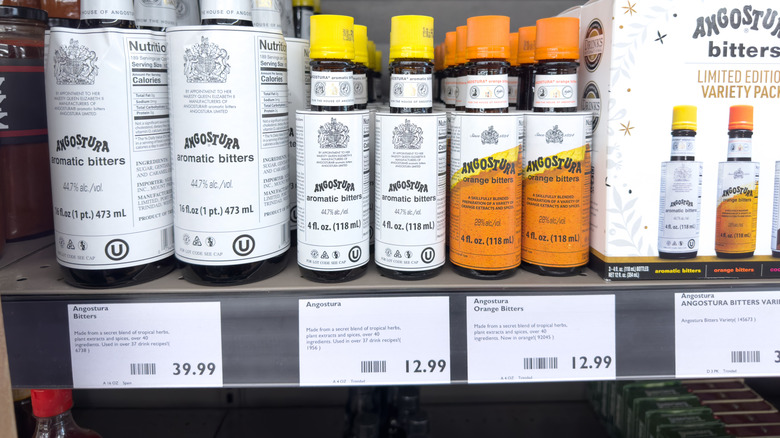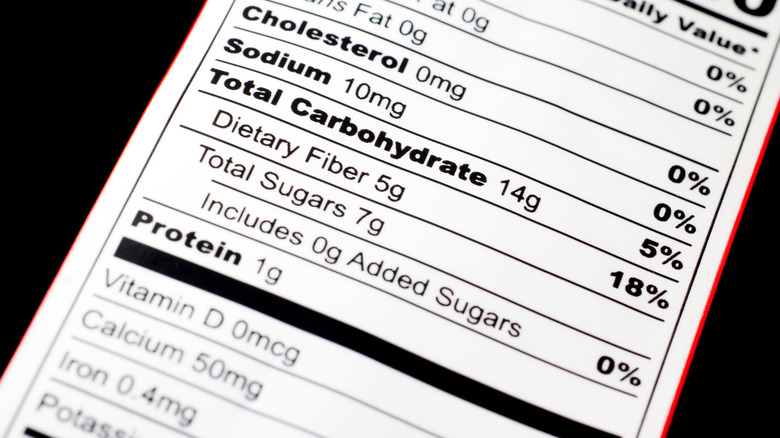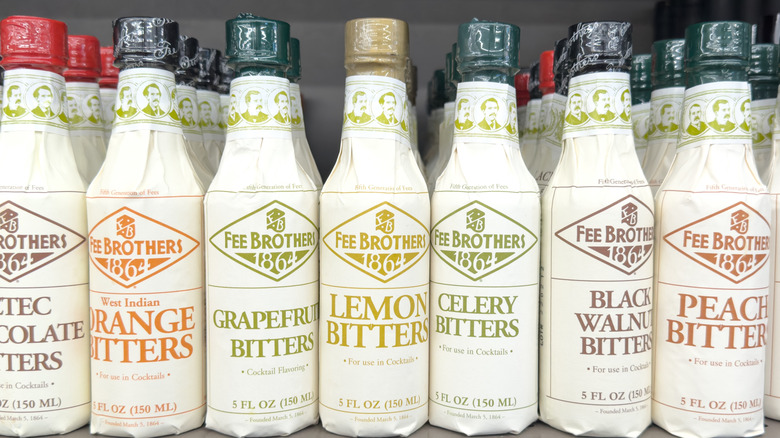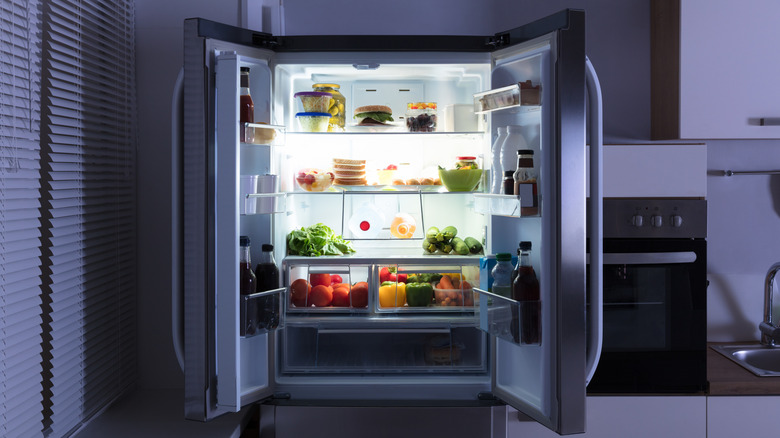What Are Bitters And How Do You Use Them In Cocktails?
We may receive a commission on purchases made from links.
While many people think of, say, gin or whiskey when they think of cocktails, several of these drinks just wouldn't be the same if it weren't for a drop or two of bitters. These herbal extracts are tiny in amount but mighty in flavor, and they can change a drink from basic to beautifully complex. Bitters have a long history and started, as so many other drinks have, as medicinal tonics. While there are still some medicinal aspects to certain types of bitters, many now are just used for their flavor.
The fact that you only need a dash or so of these bitters, and the fact that they're very much like a culinary flavoring and not a drink themselves, means they're easier to obtain. They're also very versatile and don't have to be restricted to just flavoring alcohol. If you want to up your drink-mixing game, and you haven't yet explored bitters, now's the time to do so. Here's a look at what bitters are and how you use them in cocktails.
What are bitters?
Bitters are flavorings used in cocktails, such as Old Fashioneds, and true to their name, they impart a bitter flavor to whatever you add them to. Bitters themselves may be flavored with orange, cocoa, and other foods, but the overall profile is bitter. They're usually alcohol-based, but you can find alcohol-free bitters made with glycerin. Bitters started as a medicinal aid and gradually changed into the cocktail equivalent of herbs and spices.
Alcohol-containing bitters are very high in alcohol; they can be as much as 45% ABV, or alcohol by volume. Both alcohol-containing and alcohol-free bitters have strong, intense flavors, which is why they're used in measurements of drops or dashes. Dashes tend to be less than 1/4 teaspoon. Yes, there are some cocktails that call for more, but not many.
Most commercially sold bitters use recipes that are closely guarded and not available to the public. However, a very common ingredient in most bitters is gentian (Gentiana spp.), a flowering plant with a long medicinal history. Gentiana lutea is the most common type of gentian in drinks.
How are bitters made?
As mentioned, commercial bitters tend to use secret recipes. But the general method for making them is pretty simple; the herbs and whatever other flavors you want to use are steeped in the alcohol or glycerin base (these are called solvents in bittering-speak) over a few days and then go through some combination of straining and simmering. If you're thinking that sounds an awful lot like how vanilla extract and other baking extracts are made, you'd be correct. And that's pretty much what bitters are. They're a flavoring that you add in small amounts, just like vanilla or almond extract. The only differences are that bitters are used in bar and dinner drinks instead of baked goods and desserts.
Both alcohol-containing and alcohol-free bitters have the bitter component (called the bittering agent, which is something like gentian, wormwood, cinchona bark, or another bitter ingredient) along with softer, although not necessarily sweeter, ingredients. These can be anything from the aforementioned orange or cocoa to jasmine flowers, cinnamon, or vanilla.
What do bitters taste like?
As the name suggests, when you taste bitters, you're going to taste something bitter. But the additional flavorings used in a specific bitter recipe, along with the specific drink you add the bitters to, all greatly influence what you taste in the final mixture. You'll still get that bitter undertone, but the overall flavor should be one that's much more mellow.
Bitters are created and chosen with harmony in mind. You're not trying to make your drink bitter, but you are trying to balance sweeter alcohol types with bittering agents while infusing the drink with a blend of flavors, from simple to complex. Certain bittering agents go better with certain types of alcohol. For example, orange bitters are sometimes mixed with tequila, but chocolate bitters work better with brandy. Bitters come in so many flavors that if you find you don't like one, you can easily find another to try. You may find bitters with flavors that look like something out of a bakery, or ones with floral flavorings straight out of a garden.
How do you use bitters?
In terms of physically adding bitters to drinks as a flavoring agent, all you have to do is drop in however many drops a drink recipe calls for. Many brands of bitters package them with dropper or dasher lids that allow you to control the exact number of drops that go into a drink.
In more general terms, use bitters when you want to adjust the taste of a drink and make it more interesting. Have you ever added something to cola to give it more flavor, such as adding pure vanilla extract to make vanilla cola, or maraschino cherry juice to make cherry-flavored cola? Have you ever asked a barista to add a flavored syrup to coffee? You can do the same with bitters. If you normally drink vodka without anything else except maybe ice, for example, add some bitters to make the flavor more complex.
Are bitters medicinal?
Many bitters are used for flavoring, but bitters in general started out as digestive medicines. The bitter herbs used in the concoctions often have their own medicinal uses; gentian, for example, is often tried as an herbal treatment for high blood pressure and other conditions. Unfortunately, the evidence supporting gentian as a treatment for these conditions isn't very strong, but the idea that bitter foods are good for your health is an old one. Bitter foods and compounds have a long history of medicinal use, especially in Traditional Chinese Medicine. And bitter-tasting foods, such as bitter melon and dandelion greens, do have some health benefits beyond simple nutrition. For example, bitter melon may help you control your blood glucose, and dandelion greens may help protect your liver.
Bitters do still have a medicinal use, by the way. While some bitters are used only for flavoring, digestive bitters are meant to help your digestion. Some digestive bitters are used in special drinks to be enjoyed before and after meals, called aperitifs and digestifs, respectively.
When, where, and why were bitters created?
Bitters have been around as a medicine for centuries, but the first official patent for one was for aromatic bitters in 1712. The purpose was to help with stomach ailments, but some doctors applied bitters to some off-label uses, such as soothing hangover pain. Often, the bitters were added to drinks, and over time, adding the bitters to drinks for their flavor, rather than for any medical use, became the norm. By 1806, bitters were a known cocktail ingredient.
Even after their transition from medicine to dinner-drink flavoring agent, bitters remained a common remedy for stomach problems. Angostura Bitters, which is one of the most widely known bitters around, began in 1824 expressly for medicinal use. It was created by a German army surgeon who was stationed in Angostura, Venezuela, and who needed some way to treat soldiers who were suffering from stomach ailments.
Alcoholic vs. alcohol-free bitters
The solvent used in recipes for bitters is usually a neutral alcohol. However, there are non-alcoholic bitters that use glycerin as the solvent instead of alcohol. A few non-alcoholic bitters use low-proof alcohol as the solvent, so those of you who want to or need to avoid all alcohol should check which solvent a non-alcohol product uses before cracking it open.
You really shouldn't detect a change in taste between bitters that use alcohol or glycerin. The alcohol that most bitters use is supposed to be neutral, meaning there's no real flavor to the alcohol itself that could overpower the bittering agent or other flavors. Glycerin should have little flavor, too. That means that in both types of bitters, you should end up tasting just the bittering agent and the other ingredients like cocoa, cinnamon, and so on.
Given that bitters are used in drops, should you really worry if your non-alcohol bitters actually contain a smidge of alcohol? Yes, you should. For people who can only consume non-alcoholic drinks due to religious or medical reasons, even the little bit of low-proof alcohol those bitters might contain could be harmful.
Can you make bitters yourself?
You can totally make bitters yourself. Again, recipes for commercial bitters like Angostura are company secrets, so any recipes you find that claim to be authentic likely aren't. But you can find many recipes for bitters online and in cookbooks that cover cocktails. You'll have to choose your solvent first and decide whether you want to make alcohol-containing or alcohol-free bitters, and whether you want the base for alcohol-free bitters to be glycerin or something like a caramel syrup that you cook up yourself.
You'll also need a lot of time because, while the process may not be complicated, the steeping, changing, and straining takes many hours. For example, Swedish bitters can take a good three weeks just for the infusing portion of the process. The process may change slightly, depending on the base; for example, if you try to use glycerin, you may need to cook the botanicals in some way (like toasting or sous vide) before you start to steep them. By the way, always check out the herbs used in recipes for bitters because some may have side effects or interact with any medications you're on. For example, tonka beans are sometimes part of the botanical mix, but those can interfere with medications like warfarin.
Where can you buy bitters?
Bitters are available from manufacturers and from stores that sell alcohol. Specialty stores may sell bitters in the real world, but you'll find a wide variety available online. Even though most bitters contain alcohol, sales do not appear to be restricted by age because bitters are considered to be food extracts and not alcoholic drinks, at least in the U.S.
Most major retailers have bitters available through their websites, so you can go to your favorite retailer's site if you want. Amazon, of course, has many types available, including those from well-known brands like Fee Brothers West Indian Orange Cocktail Bitters.
If you're not sure what type of bitters you'd like, you can also find sets of different flavors from different producers. For example, this Bitters Triple Play variety pack contains bottles of Angostura aromatic bitters, Peychaud's aromatic bitters, and Regans orange bitters. You can find additional variety packs with a range of flavors and brands, as well as alcohol-free bitters.
Nutritional information about bitters
Bitters aren't calorie-free or devoid of any nutrition, but the usual "serving" size is only a few drops. That reduces any nutritional benefit to essentially zero — and it makes bitters a great choice for lower-calorie cocktails. Most of the calories that you see in calorie counts for different brands of bitters come from the solvent used, and the botanical mix may provide some vitamins and minerals. But the amounts are negligible when you look at the amount you actually ingest as part of your drink.
This effective absence of alcohol and calories led to the creation of one of Julia Child's favorite cocktails. While she loved her Upside-Down Martinis, she also knew that having several of them at one party could have undesirable effects on the diet of anyone watching their weight. As a result, she created the Angosoda, which was a glass of sparkling mineral water with a dash of Angostura bitters and a slice of lime. This is essentially a soda flavored with a drop of extract, and it's a perfect compromise between the need to watch calorie intake while still enjoying a cocktail.
Varieties of bitters
Bitters come in many varieties. Some are better known by their brand names, but others are known for their main botanical or culinary ingredients. Angostura and Peychaud's are a couple of brands where the company's name has become synonymous with their products; anyone who is familiar with bitters will think of them upon hearing the name "Angostura," for example.
Other than brand name, bitters can be differentiated by flavoring type. Aromatic bitters tend to use spices and bark (think cinnamon), citrus bitters use citrus products like orange peel, herbal bitters use culinary herbs for flavor, and so on. Chocolate bitters fall under bean bitters, and you can have nut bitters, too, that use nuts like pecans for flavor. There are fruity bitters and even celery bitters. And don't forget aperitifs and digestifs; while these aren't bitters themselves, they contain bitters and are meant to stimulate appetite and help with digestion, which, when you think about it, is sort of in line with what medicinal bitters were originally meant to do.
There is one more type of bitter: the potable bitter, or bitter liqueur. Another name for these is "amaro." These are Italian bitters that are often drunk on their own, combined with soda, or mixed into cocktails (Aperol, of the famed Aperol Spritz, is a type of amaro, as is that Campari you might have had mixed with soda). They are not considered to be food extracts, by the way, and are treated as alcohol when purchasing.
How to store bitters
Whether or not to refrigerate bitters once the bottle is opened is a subject of debate. It does partly depend on the solvent; alcohol-free bitters that use glycerin, for example, should be refrigerated after opening. And any brands of bitters that have warnings to refrigerate after opening obviously need to be kept in the fridge, too.
As for alcohol-containing bitters, though, advice is mixed. Bitters that contain alcohol have so much that technically, they don't have to be refrigerated after opening (assuming the manufacturer hasn't said you have to store them in the fridge). However, that lack of refrigeration can contribute to the gradual decline in the quality of the bitters. Even refrigerated bitters will eventually be no good, but refrigeration can slow down the process and protect the flavor from the effects of oxidation. If you do want to store your bitters outside the refrigerator once you open them, keep them in a cool, dry place, out of direct light.
